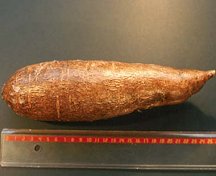Week 2
High-Energy Feedstuffs |
 |
 |
Instructions for listening to audio clips
- Download the QuickTime
Player to listen to the audio files.
- Read the QuickTime
Instructions for installation help.
- Download the RealPlayer to listen to the audio files
- Instructions are on the RealPlayer download page
Roots and Tubers
-
Text Transcript
Time: 3.26
Follow along with the audio...
- Roots and tubers
- By-products of foods produced for human consumption
- Root
- Fleshy, subterranean portion of plant
- Tuber
- Short, thick, fleshy stem, or terminal portion of stem or rhizome, usually subterranean
- Discussed as one
- Examples include potatoes, turnips, cassava, mangolds, swedes, beets, carrots, and parsnips
- Nutritional value
- 10-25% DM
- On DM basis
- Good energy source
- High in digestible nonstructural carbohydrates
- CP – 4-12%
- CF – 5-11%
- High in K; low in Ca and P
- Feeding value
- Generally ruminants
- Limit amount fed to 25% of grain
- Potatoes
- In U.S., cull, surplus, small, and by-products
- Raw
- DM basis
- High energy feedstuff
- NFE at 82-83%
- CP – 10-11%
- CF – 4%
- Processing
- Improves nutritional and feeding value
- Required for nonruminants
- Feeding livestock
- Ruminants – limit to 50% of DM
- Nonruminants – lower limit
- Do not feed sprouted, green, or frozen
- By-products
- Meal, slurry, filter cake, flakes, pulp, and dried
- High moisture products also ensiled
- Cassava
- Tropical plant
- Dried cassava meal
- Produced from root
- Figure 5.10 – Cassava root

- In U.S., primary cassava product
- High energy
- Low protein
- 83% NFE
- Low fiber
- Fresh cassava root
- 35% DM
- 30% NFE
- Low protein
- Low fiber
- Feeding livestock
- Ruminants and nonruminants
- Stems and leaves fed as forage to ruminants
- Fresh leaves and roots must be processed
- Reduce cyanogenic glycosides
|
 |
 |
|

